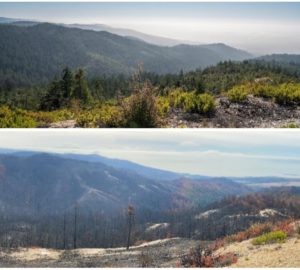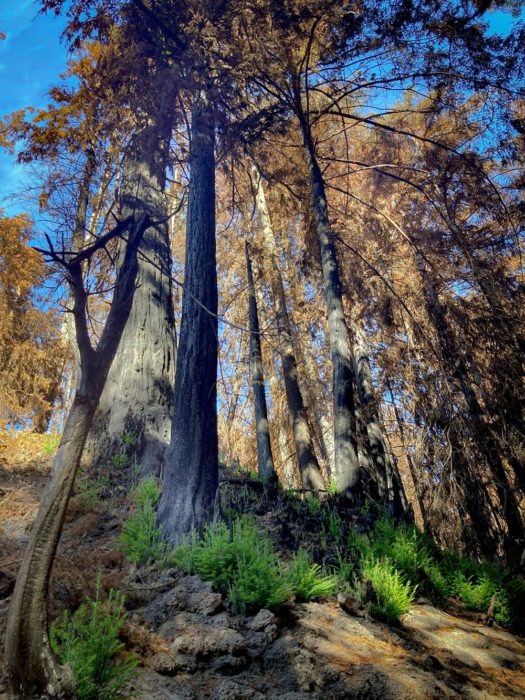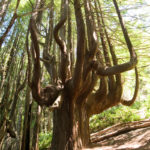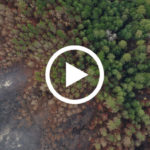Media Contact:
Robin Carr, Landis Communications Inc.
Email: Redwoods@landispr.com | Phone: (415) 766-0927

San Francisco, Calif. (December 9, 2020) — Save the Redwoods League today announced the completion of the purchase of Cascade Creek, a 564-acre property between Big Basin Redwoods and Año Nuevo State Parks. The $9.6 million project — including both land acquisition, closing and initial stewardship costs — marks a keystone connection for protected habitat from the Santa Cruz Mountains to the Pacific Ocean. It also advances the League’s goal of protecting the last of the old-growth redwood forest as identified in their 2018 Centennial Vision for Redwoods Conservation. While the entire Cascade Creek property experienced wildfire in August during the CZU Lightning Complex, the fire was a mix of low- to high-intensities, and the coast redwood and mixed conifer forest is already showing signs of recovery.
“This year’s fires have amplified our need to protect the coast redwood forest. We need resilient habitat in the face of a changing climate,” said League President and CEO Sam Hodder. “Cascade Creek contains mature second-growth redwoods and more than 100 acres of old-growth redwoods. It is a forest that — once recovered — will be a refuge of green, carbon-rich stability in a fire-impacted landscape.”

“While the forest may look rough for a few years, almost all of the coast redwoods within the Cascade Creek property appear to have survived the CZU Lightning Complex fires,” Hodder continued. “The ferns, sorrel and other understory plants are already sprouting back even in advance of the winter rains. The redwood trees are sprouting fluffy green stems up and down their trunks and along their branches. This quick regeneration forms a stable foundation on which the broader forest habitat recovery will build.”
Post-Fire Recovery at Cascade Creek
The League plans to restore and steward Cascade Creek following the recent fires. Initial rehabilitation efforts will focus on protecting the road and creekside trail from erosion and hazards. Longer term, the League will focus on promoting natural recovery wherever possible. This means managing invasive species, monitoring natural regeneration of the forest and planting on an enrichment basis where natural regeneration is not adequate.
2020 Wildfires in the Coast Redwood Range
In 2020, California more than doubled its record number of acres burned in one year. In forests and other natural lands across the state, climate change and management that has suppressed all fire for more than 150 years have resulted in intense burn conditions. As a result, fire-adapted redwood forests are facing an unprecedented test.
To date in 2020, California wildfires covered more than 81,200 acres of coast redwood forests of varied ages, approximately 4.9 percent of the total redwood range. Out of just 117,679 acres of old-growth redwood forest remaining in the world today, 11,178 acres experienced fire, which is about 9.5 percent of the ancient footprint. Initial reports suggest that the fires burned at mixed intensities throughout the coast redwood range.

Mature coast redwood trees have exceptionally thick bark that insulates them from heat and fire. Even if fire consumes their crowns, which is lethal for most conifers, the trunk of a redwood can sprout back to life. Second-growth forests, which make up 93 percent of the coast redwood range today, grow more densely and the trees have not had as much time to develop thick bark, putting them at higher risk.
“Our hearts go out to the firefighters, first responders and communities affected by the season’s wildfires,” said Hodder. “This year’s blazes underscore the critical need to protect our redwood forestland and invest in science-based forest stewardship now. This work will protect California’s redwood forests — and our neighboring communities — to ensure the collective resilience of our forests and people in the years to come.”
Purchase and Protection of Cascade Creek
The purchase and protection of Cascade Creek was made possible by the more than 6,700 donors who supported the project through the Forever Forest: The Campaign for the Redwoods, the League’s capital campaign to raise $120 million in private support to implement the early years of the Centennial Vision for Redwoods Conservation. Just over half of the Forever Forest Campaign goal — $65 million — is dedicated to protecting coast redwood and giant sequoia forests and accelerating the pace and scale of redwood conservation through strategic land acquisitions. The other half will support forest restoration and redwood park and education projects that connect all people with redwoods. Since the League launched the campaign in 2017, funds from Forever Forest have been used to acquire and protect such properties as Cascade Creek (2020), Alder Creek (2019), Red Hill (2018) and the Harold Richardson Redwoods Reserve (2018), to name a few.
“We are incredibly thankful for the stability, resilience, and generosity of the many dedicated donors who helped us safeguard this special place,” added Hodder.
Lead gifts to support the protection and restoration of Cascade Creek came from League Councilor Ralph Eschenbach together with his wife Dr. Carol Joy Provan, the Gordon and Betty Moore Foundation, project partner Peninsula Open Space Trust (POST), and the California State Coastal Conservancy. The Holmes family also agreed to reduce the purchase price, which amounted to nearly a $1 million discount on the sale of the property.
* * *
To schedule an interview, contact Robin Carr at (415) 766-0927 or redwoods@landispr.com.
To access hi-res images, drone footage, and b-roll of the Cascade Creek property, please visit our newsroom.
One of the nation’s longest-running conservation organizations, Save the Redwoods League has been protecting and restoring redwood forests since 1918. The League has connected generations of visitors with the beauty and serenity of the redwood forest. The nonprofit’s 24,000 supporters have enabled the organization to protect more than 216,000 acres of irreplaceable forest in 66 state, national and local parks and reserves. For information, please visit SaveTheRedwoods.org. For updates, please subscribe to our E-Newsletter at SaveTheRedwoods.org/signup.
Tags: 2020, Cascade Creek, land acquisition, preservation, Press Release, redwood forest conservation, Santa Cruz

